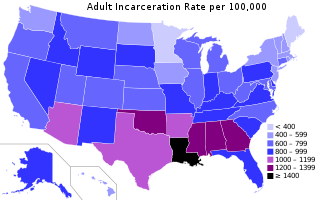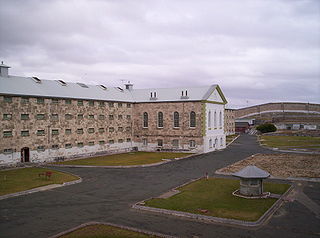Related Research Articles

The demographics of Estonia in the twenty-first century result from historical trends over more than a thousand years, as with most European countries, but have been disproportionately influenced by events in the last half of the twentieth century. The rise and fall of the Soviet Union, including the annexation and eventual independence of Estonia, has had a major effect on Estonia's ethnic makeup and educational achievement.

The economy of Estonia is an advanced economy and the country is a member of the European Union and of the eurozone. Estonia's economy is heavily influenced by developments in the Finnish and Swedish economies.
A private prison, or for-profit prison, is a place where people are imprisoned by a third party that is contracted by a government agency. Private prison companies typically enter into contractual agreements with governments that commit prisoners and then pay a per diem or monthly rate, either for each prisoner in the facility, or for each place available, whether occupied or not. Such contracts may be for the operation only of a facility, or for design, construction and operation.

Incarceration in the United States is a primary form of punishment and rehabilitation for the commission of felony and other offenses. The United States has the largest prison population in the world, and the highest per-capita incarceration rate. In 2018 in the US, there were 698 people incarcerated per 100,000; this includes the incarceration rate for adults or people tried as adults. In 2016, 2.2 million Americans have been incarcerated, which means for every 100,000 there are 655 who are currently inmates. Prison, parole, and probation operations generate an $81 billion annual cost to U.S. taxpayers, while police and court costs, bail bond fees, and prison phone fees generate another $100 billion in costs that are paid by individuals.

Prison education is any educational activity that occurs inside prison. Courses can include basic literacy programs, secondary school equivalency programs, vocational education and tertiary education. Other activities such as rehabilitation programs, physical education and arts and crafts programs may also be considered a form of prison education. Programs are typically provided, managed and funded by the prison system, though inmates may be required to pay for distance education programs. The history of and current practices in prison education vary greatly among countries.
Crime in Australia is managed by various law enforcement bodies, the federal and state-based criminal justice systems and state-based correctional services.

Crime in Sweden describes an act defined in the Swedish Penal Code or in another Swedish law or statutory instrument for which a sanction is prescribed.

Crime in the United States has been recorded since the early 1600s. Crime rates have varied over time, with a sharp rise after 1900 and reaching a broad bulging peak between the 1970s and early 1990s. After 1994, crime rates began to fall year by year. This trend lasted until 2015, where crime rates began to rise slightly. This reversed in 2018 and 2019, but crime increased significantly again in 2020. Despite the increase in crime between 2020 and 2021, the quantity of the increase in overall crime is still far below the peak of crime seen in the United States during the late 1980s and early 1990s.

Crime in Italy ranks from low to moderate, but is present in several forms, such as murder, sexual violence, corruption, and several more. However, Italy is most notorious for its organised crime groups, present all over the world, known as the Italian Mafia. These crimes are combated by the spectrum of Italian law enforcement agencies, composed of Carabinieri, Polizia, and Guardia di Finanza. Italy holds the 8th position in Europe in regards to the number of law enforcement per 100 thousand people with 453 units, compared to the European average which is 335. Although crime covers the Italian Peninsula, Italy holds some of the lowest toll of rapes and murders in the European Union. Out of 128 countries, Italy is the 40th safest country in the world.
This is a list of New Zealand's international rankings on a range of social, economic and other criteria.

In September 2013, the incarceration rate of the United States of America was the highest in the world at 716 per 100,000 of the national population; by 2019 it had fallen to 419 per 100,000. Between 2019 and 2020, the United States saw a significant drop in the total number of incarcerations. State and federal prison and local jail incarcerations dropped by 14% from 2.1 million in 2019 to 1.8 million in mid-2020. While the United States represents about 4.4 percent of the world's population, it houses around 22 percent of the world's prisoners. Corrections cost around $74 billion in 2007 according to the U.S. Bureau of Justice Statistics (BJS). According to the Justice Expenditures and Employment in the United States, 2017 report release by BJS, it’s estimated that county and municipal governments spent roughly $30 billion USD on corrections in 2017.
The drug policy of Sweden is based on zero tolerance focusing on prevention, treatment, and control, aiming to reduce both the supply of and demand for illegal drugs. The general drug policy is supported by all major Swedish political parties with the exception of the Left Party.

Prisons in the Republic of Ireland are one of the main forms of punishment, rehabilitation, or both for the commission of an indictable offense and other offenses. Prisons in Northern Ireland, part of the United Kingdom, are run by the Northern Ireland Prison Service.

Punishment in Australia arises when an individual has been convicted of breaking the law through the Australian criminal justice system. Australia uses prisons, as well as community corrections. The death penalty has been abolished, and corporal punishment is no longer used. Prison labour occurs in Australia, prisoners are involved in many types of work with some paid as little as $0.82 per hour. Before the colonisation of Australia by Europeans, Indigenous Australians had their own traditional punishments, some of which are still practised. The most severe punishment by law which can be imposed in Australia is life imprisonment. In the most extreme cases of murder, courts in the states and territories can impose life imprisonment without parole, thus ordering the convicted person to spend the rest of their lives in prison.

This article discusses the incarceration of women in correctional facilities. According to a study reported in September 2014 by the International Center for Prison Studies, as of August 2014, across the world, 625,000 women and children are being held in penal institutions with the female prison population growing on all five continents. See: List of countries by incarceration rate. It has a section with a table for percent of female prisoners by country.

The Federal Penitentiary Service is a federal agency of the Ministry of Justice of Russia responsible for correctional services.
Suicide in Lithuania has become a significant social issue in the country due to its high rate. Since its peak in 1995, the suicide rate in Lithuania has been constantly decreasing, but it still remains the highest in the EU and the OECD.

The United States has the highest prison and jail population, and the highest incarceration rate in the world. According to the World Prison Population List there were around 10.35 million people in penal institutions worldwide in 2015. The US had 2,173,800 prisoners in adult facilities in 2015. That means the US held 21.0% of the world's prisoners in 2015, even though the US represented only around 4.4 percent of the world's population in 2015.
References
- ↑ Intitutions
- 1 2 International Centre for Prison Studies: Estonia Archived 2012-03-22 at the Wayback Machine Retrieved 2011-07-29
- ↑ International Centre for Prison Studies: Europe - Prison Population Rates per 100,000 Retrieved 2011-07-29
- ↑ (from the estonian prisons official webpage).
- ↑ Prison_population 2002-2012 ec.europa.eu